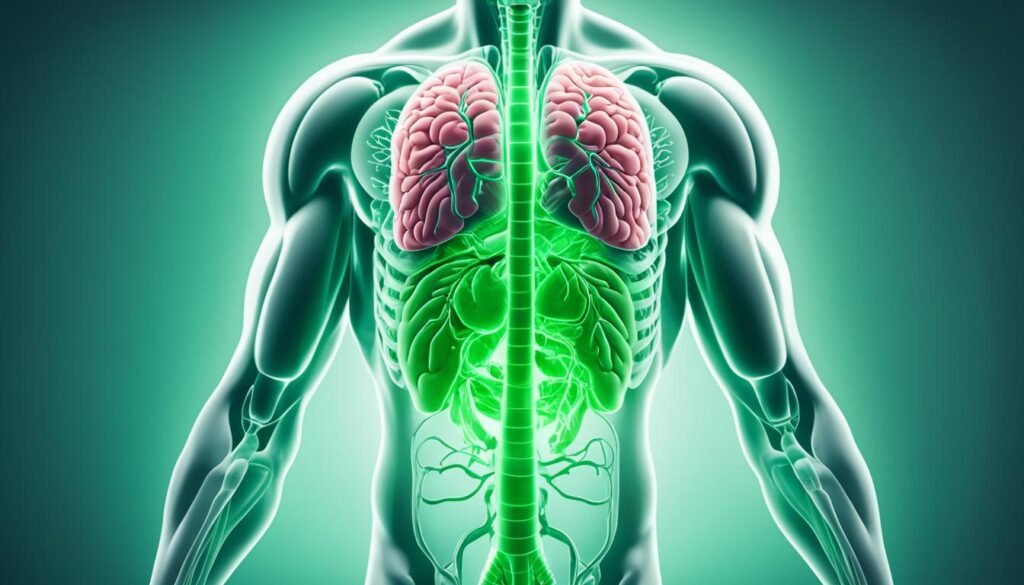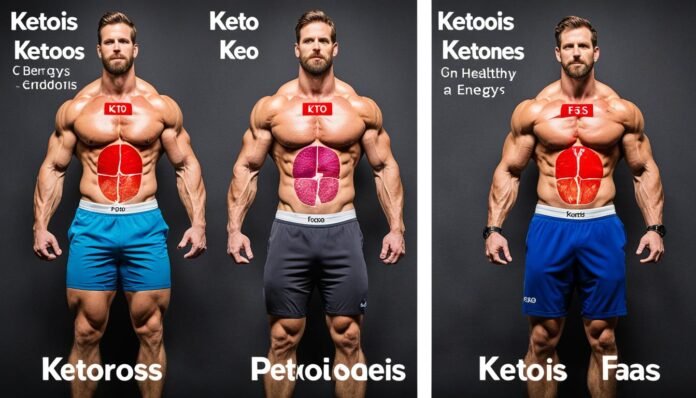Embarking on a keto diet means you’ll learn about how your body handles fat. You’ll need to understand terms such as nutritional ketosis and diabetic ketoacidosis. These states are about how your body makes ketone bodies, but they affect your health differently. Let’s dive into the differences. This way, you can stay healthy while you enjoy the ketogenic diet.
What is Ketosis?
Ketosis is when the body uses ketones for energy instead of glucose. This happens when you eat fewer carbs, fast, or do a lot of exercise. The body breaks down fat stores, making ketones for energy.

Definition and Process
Your body starts burning fat instead of sugar when carbs are low. This makes blood sugar drop, so your liver turns fat into ketones. Then, your brain uses these ketones for fuel.
Causes of Ketosis
Ketosis usually starts with a low-carb diet, like the keto diet. Fasting and intense workouts can also lead to ketosis. People with eating disorders or who fast a lot might experience it too.
Health Benefits
One key benefit of ketosis is weight loss. Using fat for energy can help you burn more fat. Ketosis can also even out blood sugar levels. This is good for insulin sensitivity and keeps your energy stable.
Possible Risks
However, ketosis has some risks. You might not get enough nutrients if your diet isn’t balanced. It can also strain your kidneys. It’s important to have a doctor check on you. They should monitor your blood sugar to prevent problems.
What is Ketoacidosis?
Diabetic ketoacidosis (DKA) is a critical condition caused by a severe insulin shortage. This leads to high blood sugar levels. It also causes a buildup of acids called ketones to dangerous levels. These high levels can cause serious health issues.
Definition and Process
DKA mainly affects people with type 1 diabetes. Without enough insulin, the body breaks down fat for fuel. This action and high sugar lead to acidic blood, a serious risk without treatment.
Causes of Ketoacidosis
Missing insulin doses, infections like pneumonia, or other illnesses can trigger DKA. Insulin resistance makes it worse by stopping glucose from entering cells. This forces the body to use fats for energy.
Symptoms and Complications
DKA’s symptoms include intense thirst, often urinating, nausea, vomiting, stomach pain, and confusion. Untreated, it can cause severe dehydration, brain swelling, or coma.
Treatment and Management
Immediate medical help is needed to treat ketoacidosis. It involves fluids, balancing electrolytes, and insulin to lower sugar. For those with type 1 diabetes, close monitoring of sugar levels and sticking to insulin therapy is vital.
| Aspect | Ketoacidosis | Ketosis |
|---|---|---|
| Cause | Severe insulin shortage | Low carbohydrate intake |
| Population | Type 1 diabetes primarily | General, those on a low-carb diet |
| Health Impact | Potentially fatal | Generally safe |
| Ketone Levels | Toxic | Controlled, moderate |
| Treatment Required | Immediate medical attention | Diet and lifestyle management |
Ketosis vs Ketoacidosis
Let’s explore the main differences between
. Their causes and effects are very different. Ketosis is a safe metabolic state. It happens when you eat a low-carb diet, fast, or do a lot of exercise. This state can help with weight loss and improve health, if you manage it right.
Diabetic ketoacidosis (DKA), however, is very serious. It usually occurs in people with type 1 diabetes. Not having enough insulin leads to very high blood sugar levels and ketone levels. This causes the blood to become acidic. People with DKA need medical help right away because it’s very dangerous.
Here’s a table that shows how ketosis and ketoacidosis are different:
| Aspect | Ketosis | Ketoacidosis |
|---|---|---|
| Cause | Low-carb diet or fasting | Insufficient insulin, typically in type 1 diabetes |
| Ketone Levels | Mildly elevated | Extremely high |
| Blood Sugar Levels | Normal or low | High |
| Health Impact | Metabolically beneficial | Potentially fatal |
| Treatment | Diet management | Immediate medical treatment |
Keeping track of nutritional ketosis means watching your blood sugar levels and ketones. Regular checks can tell you if you’re in a healthy state of ketosis or facing the risk of diabetic ketoacidosis. Knowing these differences helps you make smart choices about your health and diet.
How to Enter and Maintain Ketosis
Starting your ketosis journey means adjusting what you eat. You’ll need to eat less than 50 grams of carbs each day. Lowering carbs this way makes your body use fat for energy, instead of sugar. People following a keto diet often see big wins like less hunger, more weight loss, and better cholesterol levels.
To keep in ketosis, eat lots of fats and a good amount of protein. Also, choose low-carb veggies and whole foods for key nutrients. Your body might need a few days to get used to burning fat. Watching what you eat is critical to stay in ketosis safely over time. Mixing in a variety of food with nutrients helps keep you in ketosis.
It’s important to check your ketone levels regularly. Using tools like ketone strips or blood ketone meters helps track your progress. Remember, ketosis isn’t just about eating fewer carbs. It’s about a balanced keto diet full of nutrition. This supports your health benefits and helps with your weight loss journey.





